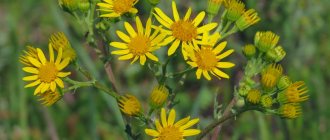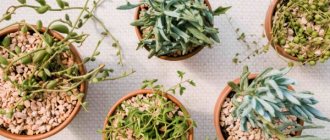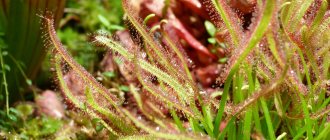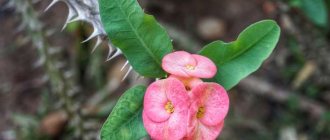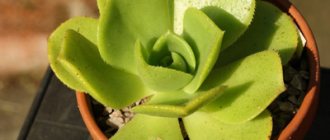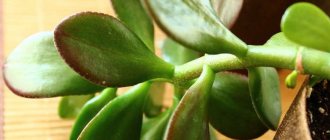Large-tongued ragwort , however, does without either “gray hair” or “baldness.”
Large-tongued ragwort is a tall evergreen vine with fleshy leaves up to 8 cm long - green or variegated, decorated with yellowish-white stripes and spots.
The shape of the leaves is triangular or pentagonal, with a protruding central segment, the same “tongue” with clear straight sides, from which this type of ragwort received the Latin name “Senecio macroglossus” (“big tongue”).
In nature, this vine grows in South Africa, including in the dry areas of the province of Natal. This is where another name for the plant comes from: “Natal ivy” .
In appearance , the large-tongued ragwort is indeed similar to ivy, but has a characteristic difference: typical succulent leaves: dense, “well-fed”, with a waxy coating.
The fact that Natal ivy is a leafy succulent explains the origin of another name under which this vine is often sold: kleiniya . This name is given in honor of the German botanist Klein, who studied the succulent forms of ragworts.
In addition to attractive leaves with a reddish central vein and brownish-purple, violet cuttings, “Natal ivy” is decorated with small pale yellow flowers similar to daisies in winter and early spring.
The sap of the plant is poisonous. If it comes in contact with the skin, it can cause irritation and allergic reactions; if it gets inside the body, it can cause poisoning.
Therefore, large-tongued ragwort should not be grown where there are pets and small children.
Description of the plant
Ragwort is a tall vine that has fleshy leaves of variegated green color. There are white spots of various shapes and sizes on the foliage of the plant. It has a triangular or pentagonal shape and has a central protruding segment. The place where the liana grows in natural conditions is South Africa.
In appearance, the flower is similar to ivy. A distinctive feature between these plants is the original foliage of the ragwort. The inflorescences of the crop are collected in baskets and can have a variety of sizes. Growing a flower can be done indoors or on the balcony. The plant is characterized by the presence of white flowers with a yellow center, which allows it to be used to decorate the design of a room or garden.
Flower care
To ensure full growth and flowering of the large-tongued ragus, it is necessary to properly care for it. The plant needs:
- Proper lighting
- Optimal temperature
- Moderate watering
- Feeding
Planting a flower should be done in well-lit areas. That is why, if it is grown indoors, it must be placed on a south or west window. It is recommended to ensure that the flower is not exposed to direct sunlight.
In spring and summer, it is recommended to grow the flower at a temperature of 22 to 26 degrees. In autumn, it is gradually reduced to 12-15 degrees. In winter, it is recommended to ensure that the temperature is at least 7 degrees. There is no need to humidify the air during the cultivation of ragwort. This is explained by the fact that it is able to fully grow in tropical conditions.
In spring and summer, the plant needs to be provided with moderate watering. After the top layer of soil has dried, you need to wait a few days and water the plant. In the autumn, watering is reduced. It is not recommended to carry out this procedure in winter. Some gardeners water the ragwort once a month. To water the plant, only soft and settled water is used. You should not overdo it in watering, as this can lead to rotting of the root system.
In order to ensure abundant flowering of the crop, it is recommended to fertilize it. For this purpose, it is recommended to use fertilizers for succulents. The procedure is recommended to be carried out once every two weeks in the spring and summer.
Large-tongued ragwort is characterized by ease of care, which allows even an inexperienced gardener to grow it.
Contraindications
There are quite a few contraindications for preparations made from ragwort. They cannot be used for organic diseases of the heart and blood vessels, when blood circulation is impaired, as well as in the presence of organic disorders in the functioning of the liver and kidneys. They are contraindicated for glaucoma. You should be wary of an overdose of the drug. In this case, palpitations and dry mouth occur, and the pupils dilate.
Recipes
- For stomach ulcers: one teaspoon of dry ragwort is poured into two glasses of boiling water. Leave for one hour, then strain. Take the infusion one tablespoon three times a day before meals.
- For abscesses, apply compresses. To do this, take fresh leaves of the plant (two tablespoons), pour half a liter of boiling water over them and leave for half an hour. The liquid is filtered and used for compresses.
- Hemostatic tincture of roots: twenty-five grams of crushed raw materials are poured with half a glass of seventy percent alcohol. Leave for two weeks, stirring regularly, then filter and squeeze. Take thirty to forty drops diluted in fifty milliliters of water, one to three times a day, fifteen minutes before meals.
Features of transplantation and reproduction
During the period of plant transplantation and propagation, the correct selection of soil mixture plays a very important role. To plant the plant, nutritious and loose soil is used, which is characterized by a neutral alkaline balance. Quite often, ready-made substrates are used in which bushes and succulents are planted.
Young ragwort large-tongued should be replanted every year. The procedure should be carried out in the spring. Adult plants need to be replanted every 2-3 years.
Cuttings, layering and seeds can be used to propagate the crop. For propagation by cuttings, shoots are used, the size of which is from 8 to 10 centimeters. You need to remove a few leaves from the bottom. It is recommended to leave the shoots for several hours to dry. To root cuttings, you need to use small pots, which are pre-filled with sandy soil and placed in a bright and warm place. After the cutting has rooted, it is planted in a permanent pot.
Seeds for plant propagation are used a little less frequently. To ensure good germination, preference is given to fresh planting material. The seeds must first be germinated, and then planted in small pots, several at a time. A spray bottle is used to moisten the crops. After the plant reaches a few centimeters in height, the seedlings need to be picked. One plant is planted in a pot whose diameter is 5 centimeters.
The flower can be propagated using layering. For this purpose, a small pot with fertile soil is placed next to it. Long shoots are placed in the ground and pressed tightly. After the plant has rooted, the shoots are cut off from the mother flower.
Reproduction of the cross is a fairly simple procedure and is accessible to any interested gardener.
The soil
The easiest way is to use ready-made soil mixtures made for cacti and succulents. If it is not possible to buy a ready-made substrate, you need to select a loose, moderately nutritious and acid-neutral soil. It can be a mixture of leaf soil and coarse sand (2:1); some specimens grow better in a sandy-clay substrate. Much depends on what the plant is used to, therefore, when purchasing an already grown specimen of a flower in a pot, you should pay attention to what it grew in, or ask the seller about the composition of the soil.
Pests and diseases
Despite the ease of growing the plant, if not properly cared for it can be affected by a variety of diseases and pests. The plant is quite often affected by aphids, mealybugs, and spider mites. Aphids are most often observed on young shoots, which leads to their yellowing. When this pest appears, the plant must be treated with warm water. If this control measure does not help, then an appropriate insecticide is used.
If a plant is infested by spider mites, the leaves turn brown. To eliminate this pest, regular air humidification is required. If the infection is noticed untimely, then Actellik must be used to treat the flower. Mealybugs suck the juice from the leaves of the plant. To eliminate this pest, an alcohol and soap solution is used.
Among diseases, the plant is most often affected by powdery mildew. In this case, a white powdery coating appears on the inflorescences, which leads to the loss of decorative properties of the ragwort. If the plant is fed with nitrogen fertilizers, this often leads to the appearance of a disease. With powdery mildew, all affected parts of the flower are removed. To treat ragwort it is necessary to use Flundazol.
The plant may also be affected by gray rot, which is characterized by the appearance of dry spots on the foliage. The disease appears when the soil is excessively moist, low temperature or insufficient light. To eliminate the disease, it is necessary to provide the ragwort with optimal growing conditions. To treat the flower, you must use copper oxychloride.
The ragwort is large-tongued. Description
Common groundsel (Senecio macroglossus) is a vine with long brownish stems. It is often confused with common ivy, but the difference between them is very noticeable due to the larger, dense leaves of the groundsel.
The leaves are located on small petioles, alternately, triangular in shape, leathery, shiny, dark green.
Large-tongued groundsel photo. The most attractive are variegated forms, with yellow or white spots and stripes along the edges.
It blooms, as a rule, in winter, with small yellow flowers collected in axillary or apical baskets.
The plant may lose its external attractiveness in case of possible exposure, and to prevent this from happening, it is recommended to periodically rejuvenate it: pruning and cuttings.
Home care
Location
It prefers a well-lit place with enough direct sunlight, and therefore it is recommended to grow it on southern, eastern or western windows. Only in this case can the brightest color be achieved.
Temperature
In the spring-summer period, the optimal temperature will be 22 - 25 degrees. In winter, the plant can withstand temperatures dropping to 12–15 degrees, but not lower than 7–8 degrees.
Watering and air humidity
Thanks to the fleshy leaves that can retain moisture for a long time, the flower does not need frequent and abundant watering. However, the soil should not be allowed to dry out: between waterings it should only dry out slightly.
Tolerates dry air well in apartments with central heating and does not require additional humidification
In autumn, the moisture content of the substrate should become more moderate, and in winter it can be reduced to nothing, or the plant can be watered extremely rarely. For the large-tongued groundsel, the most dangerous thing is stagnation of water when the soil is waterlogged, rather than its overdrying.
Soil and fertilizers
The most suitable soil is a loose, breathable, nutritious substrate with neutral acidity. A mixture of sand and leaf soil in a ratio of 1:2 works well.
In specialized stores you can purchase ready-made soil mixtures intended for growing succulents or cacti
As a top dressing, you should choose mineral fertilizers for succulents, which are used to feed the plant twice a month in the spring and summer.
Ragwort propagation
They are propagated in several ways: by seeds, layering and cuttings.
Propagation by seeds is the least common way to grow ragwort, because this requires a lot of time and patience from the grower.
Seeds for sowing must be fresh and of high quality - only in this case can the desired result be obtained.
Sprouted seeds should be placed in one small container - this way you can get a lush, quickly growing flower. Young shoots should be regularly moistened from a spray bottle with soft, settled water.
Reproduction by layering occurs as follows: small pots filled with soil are placed next to the overgrown mother plant.
Next, you need to select the longest and healthiest shoots, place a few in each pot and press.
After a while, when the shoots take root, they are cut off from the mother plant.
Propagation by cuttings is the simplest and most accessible way to propagate large-tongued ragwort. It is necessary to cut off shoots 8–10 centimeters long, remove a couple of lower leaves and leave to dry for several hours.
Root the cuttings in small pots with sandy soil, in a warm and bright place. When they get stronger, they are transplanted into a large pot, several at a time, in order to obtain a lush and beautiful adult plant.
Features of cultivation
Juvenile forms are considered the most attractive, that is, young plants that have not yet begun to look for support. They are the owners of the largest and most beautiful leaves.
To create a densely leafy, lush composition that effectively climbs along decorative arches or supports, you need to plant several plants in one pot. However, it is recommended to grow them separately and only when they begin to curl, plant them in a single container.
To create a beautiful composition, you should independently help the young stems wrap around a single pole, cord or the handle of a flower pot.
, the following difficulties may arise :
• Leaves dry out and soon die if the temperature is too high, if there is insufficient or irregular watering, or if the air humidity is low.
• Brownish-brown spots indicate frequent watering with cold water or in wet weather, which inevitably leads to stagnation of water in the roots and their subsequent rotting.
• Variegated leaves become pale and monochromatic when the pot is too crowded or there is insufficient lighting.
• If the plant is exposed to direct sunlight for a long time, dry brown spots may appear on the leaves.
• In case of insufficient lighting, the leaves become smaller, the shoots become elongated, as a result of which the plant loses its high decorative qualities.
Rustic ragwort: diseases and pests
A distinctive feature of the flower is the fact that it is very rarely affected by diseases and pests. However, under unfavorable external factors, spider mites, aphids, scale insects may appear, and diseases such as gray rot and powdery mildew may develop.
How to grow from seeds?
The easiest way to grow ragwort from seeds is self-sowing. If you like this plant and don’t care where it grows, you can let propagation take its course. The seeds are easily dispersed by the wind (like dandelion). Bushes grown in the wrong place can either be replanted or weeded out.
Seeds of graceful groundsel without stratification have low germination.
When sowing them for seedlings, this procedure must be carried out. With self-seeding, nature itself will take care of this. If you don't trust your plants to reproduce on their own, there are three ways to do it under control:
- Sow the seeds directly into the ground in the desired location.
- Buy seedlings at the market.
- Grow it yourself.
On sale you can find hybrids (F1) of graceful groundsel. It is not recommended to let them self-sow.
You can collect your own seeds in the fall or purchase them at the store. Growing ragwort seedlings is not particularly difficult - it is not a capricious plant. But still, certain conditions must be observed. There are two ways to stratify the seeds of this plant.
Method 1 (one month before sowing):
- melt the snow and soak two cotton pads in melt water;
- Place ragwort seeds on one of them, cover with a second disk and place them in a zip-lock bag;
- place the bag of seeds under the freezer in the refrigerator (temperature should be 1 - 5 oC) for a month;
- once every three days the bag should be opened briefly for ventilation;
- In the last week, use alternating temperatures, that is, keep it in the refrigerator at night and on the windowsill during the day.
Method 2:
- prepare a container with soil;
- sow seeds in moist soil;
- close the container with a lid or cling film;
- place in the refrigerator for a month;
- then proceed as in method 1.
How to grow graceful ragwort seedlings:
- After stratification, seeds are sown in late March - early April.
- The container is filled with soil, the seeds are laid out on the surface and sprinkled with a layer of 0.5 - 0.7 cm of soil.
- The surface is moistened with a spray bottle.
- Covered with a lid, film, glass.
- Ventilation is carried out periodically.
- When shoots appear, remove the cover.
- The soil should be moderately moist - neither drying nor waterlogging should be allowed.
- After two to three weeks, when the seedlings have three or four true leaves, the seedlings are plucked. To do this, you can use either separate cups or another container - larger and deeper.
- After two and a half months, the seedlings are planted in a permanent place.
Large-tongued variegated groundsel, what it looks like, what family it belongs to
Macroglossus belongs to the Asteraceae family or, as it is also called, Asteraceae. It can be either in the form of a vine, or in the form of a subshrub, shrub, or tree. Due to its high resistance to weather changes, it can grow anywhere on the planet.
Depending on the species and local climate, the shape of the plant can vary significantly. When the seed pods are empty, the stems do not always become pubescent - they, like the leaves, may remain bare. Leaves can be whole or dissected, oval or heart-shaped, elliptical, lobed or pinnate.
This is interesting! The cross came to Europe from Africa, Namibia. Under the positive influence of climate, it reached a length of 50 cm and was quite sprawling, which is why it attracted biologists of that time. Taking it for examination, they distributed the seeds throughout the world.
Large-tongued ragwort is an evergreen vine. The leaves of the flower are triangular or pentagonal in shape, with one end protruding more than the others. This is the “tongue” from which the plant gets its name. The length of the leaves can reach 8 cm. Their color is variegated, green with yellowish-white spots and stripes.
Note! The sap of the plant is poisonous, so it is better to grow it away from animals and children.
Popular varieties of ragwort
The tallest representative of the Senecio species is the perennial ragus of the Haworth variety. Its length can reach 30 cm, shoots can be either single or branched. Even when hatching, the leaves acquire silvery fluff; in adult plants they are up to 6 cm long. The flowers of Senecio Haworthii are dim, yellow or orange, and have a spherical shape.
Other varieties of godson:
- Creeping evergreen groundsel is a perennial, not covered with silvery down. From the description of the culture it is clear that it reaches a height of only 20 cm and has rough stems (6 mm). The leaves, shaped like lancelets, can be up to 4 cm long. All flowers are painted white and have the shape of baskets. The leaves are distinguished by a greenish-blue tint.
- Senecio cultivar Herreianus. Its second name is Nailleaf. The leaves of the crop are similar in appearance to gooseberries and have slightly pointed ends. This variety needs to be grown in a sufficiently lit place, but at the same time it should not be exposed to sunlight - the leaves can get burned.
- Raspberry variety Fulgens. It is distinguished by bright, almost fiery, flowers on thin stems, round flattened leaves of a bluish tint. Many gardeners also call it Kleinia Fulgens.
- Raspberry Blue differs not only in color. This plant has arrow-shaped leaves, from under which flower stalks emerge in the form of baskets. The leaves can be either flattened or quite voluminous.
- Greater Tolstovaty ragwort was discovered in Madagascar and brought by researchers. It was large in size and could reach a height of half a meter. Moreover, the leaves themselves were no more than 5 cm, everything else was stems. Senecio major Crassissimus can be green or have a blue or gray tint.
- Ficus ragus. It has recumbent, weakly branched stems and narrow elongated leaves of gray-green color. In April-May, small greenish-white flowers appear on it.
Blooming ragwort mikaniiformes
Many people, especially beginners, confuse ragwort with ivy because of the shape of the leaves of some of its varieties. This comparison is incorrect, since these are representatives of different families.
Dosage forms, method of administration and dosages of ragwort preparations
Effective medicines and forms used in the treatment of many diseases are made from ragwort leaves. Let's look at the main ones.
To relieve acute ulcerative pain, as well as intestinal, hepatic, and renal colic, platyphyllini hydrotartras (Platyphyllini hydrotartras) is injected under the skin, 1–2 ml of a 0.2% solution. For course treatment with platyphylline (10–15–20 days), 0.003–0.005 g or 10–15 drops of a 0.5% solution are prescribed orally 2–3 times a day, or 1–2 ml of a 0.2% solution is injected subcutaneously . The drug can also be prescribed in suppositories of 0.01 g 2 times a day or in a microenema of 20 drops of a 0.5–1% solution 2–3 times a day.
In ophthalmic practice, a 1% solution of platiphylline hydrotartrate is used for diagnostic purposes and a 2% solution for therapeutic purposes. Children are prescribed 0.0002–0.003 g (0.2–3 mg) per dose, depending on age. Higher doses for adults orally and subcutaneously: single dose 0.01 g, daily dose 0.03 g.
Store the drug platiphylline in well-closed containers and ampoules.
Tepafillin tablets
(
Tabulettae "Thepaphyllinum"
) contain: platiphylline hydrotartrate 0.003 g, papaverine hydrochloride and phenobarbital 0.03 g each, theobromine 0.25 g. Tepaphylline is prescribed 1 tablet 2-3 times a day.
Tablets "Palufin"
(
Tabulettae “Palufinum”
) contain: platyphylline hydrotartrate 0.005 g, phenobarbital and papaverine hydrochloride 0.02 g each. “Palufin” is prescribed 1 tablet 2-3 times a day.
Plavefin tablets
(
Tabulettae "Plavefinum"
). Combined tablets containing platiphylline hydrotartrate 0.005 g, papaverine hydrochloride 0.05 g, caffeine 0.1 g, potassium bromide 0.15 g. To prevent sea and air sickness, “Plavefin” is taken orally, 1 tablet. The highest daily dose is 4 tablets.
https://ruspromedic.ru/lekarstva-i-preparaty/preparaty/4676-krestovnik.html
https://proklumbu.com/otkrutui-grunt/odnioletniki/krestovnik-obyknovennyj.html
https://wiki.secret-dolgolet.ru/%D0%9A%D1%80%D0%B5%D1%81%D1%82%D0%BE%D0%B2%D0%BD%D0%B8%D0 %BA_%D1%88%D0%B8%D1%80%D0%BE%D0%BA%D0%BE%D0%BB%D0%B8%D1%81%D1%82%D0%BD%D1%8B %D0%B9
Flowering and dormant period of the plant
During the flowering period, ragwort most of all needs nutrients and proper care. It is imperative to monitor air humidity and temperature. The latter should be within +24 degrees during the growing season and +15 degrees during the dormant period.
Type and shape of flowers
When flowering occurs, you can notice differences in the inflorescence of individual species. They can be collected in scutes or remain solitary, have a small or large size. The flowers themselves can be basket-shaped.
Reproduction of Senecio macroglossus
Reproduction of ragwort can be carried out using cuttings, layering, seeds and leaves.
Leaf and stem cuttings
By cuttings we mean small parts of the stem, about 9 cm long. A couple of lower leaves are removed from them and left overnight in the open air. During this time, the stem dries out a little, and it is planted in a specially prepared sandy soil mixture. It is desirable that there are no weeds in it. You can control the climate in which the cuttings will be located and move them if necessary. Several stems are planted in one pot. Transplantation is done after rooting.
By layering
To obtain layering, you need to place several small pots with prepared soil with nutrients near the already mature ragwort. After this, the leaf or even the stem must be bent so that it touches the soil in the additional pot. After rooting, the shoots need to be trimmed as carefully as possible.
Seeds
Gardeners do not recommend propagating ragwort using seeds, since they are rarely available fresh in stores. If you still managed to buy them, then several seeds, pre-moistened with water, are sown in one pot. This is done so that sprouts appear on them. Watering should only be done with a sprayer so as not to flood the seedlings.
Growing and Reproduction
Note! Cultivation occurs until the cotyledon phase begins. Then each sprout is transplanted into a separate pot with a diameter of no more than 6 cm.
Possible problems in growing ragwort
The plant is quite resistant to climate change and various pests, but it needs to be looked after constantly to prevent aphids, mites or scale insects from appearing.
Diseases and pests
The most common pest is aphids, which settle on young stems or cuttings. This is accompanied by a sharp cessation of development of the entire plant, as well as yellowing of the leaves and browning of the flowers. To get rid of aphids, you need to constantly spray the leaves with insecticides.
If a spider mite appears, a web will certainly appear on one side of the leaves. The leaves also darken noticeably and may wrinkle. To get rid of the pest, you need to increase the air humidity and spray the entire plant with warm water.
Large-tongued ragwort is grown both in the garden and in pots. It can also be cultivated for further cutting of flowers into bouquets. The plant differs in appearance depending on the species and climatic conditions of the area where it grows.
Useful video
Important tips for caring for succulents can be found in the video:
Correct care and attentive attention to the plant’s signals about a problem will ensure that indoor ragwort will not disappoint its owner for a long time. And its aesthetic appearance will allow the succulent to be included in a wide variety of flower ensembles.
READ ABOUT OTHER SUCCULENTS: GASTERIA, COTYLEDON, LITHOPS, REJUVENER, SEDUM, a href=”https://botanicoved.com/komnatnye/sukkulenty/raznovidnosti-sukkulenty/pahifitum.html” rel=”noopener” target=”_blank”> PACHYPHYTUUM, PORTULACARIA, SEDEVERIA, STAPELIA, HAWORTIA, EONIUM, ECHEVERIA.
